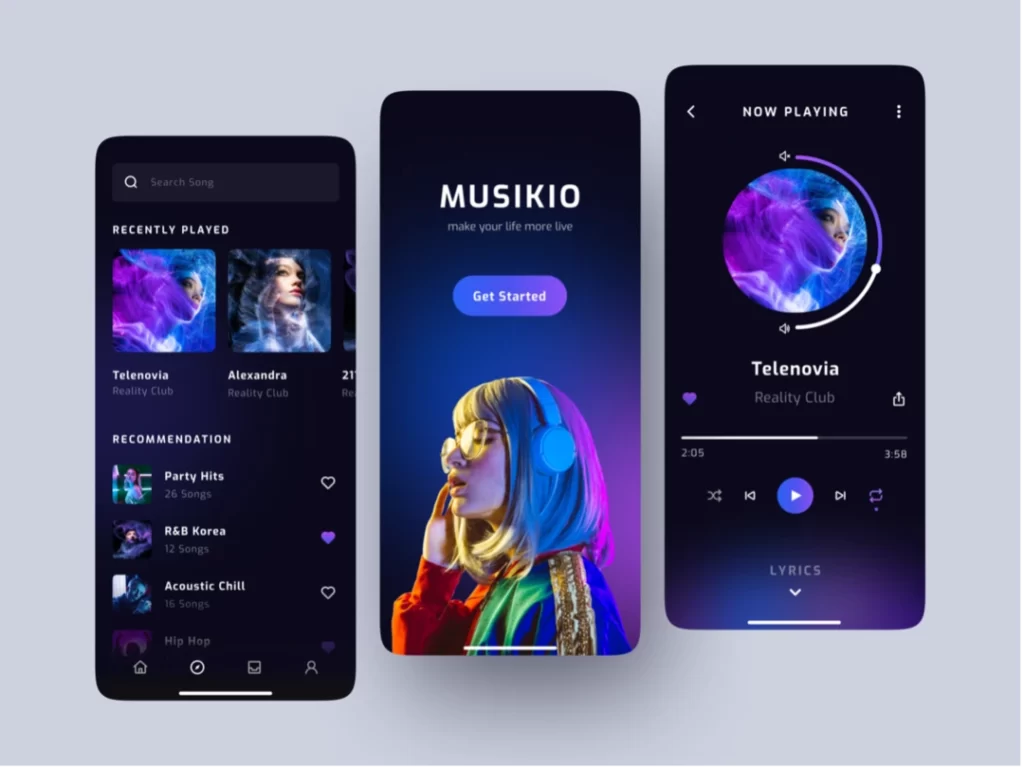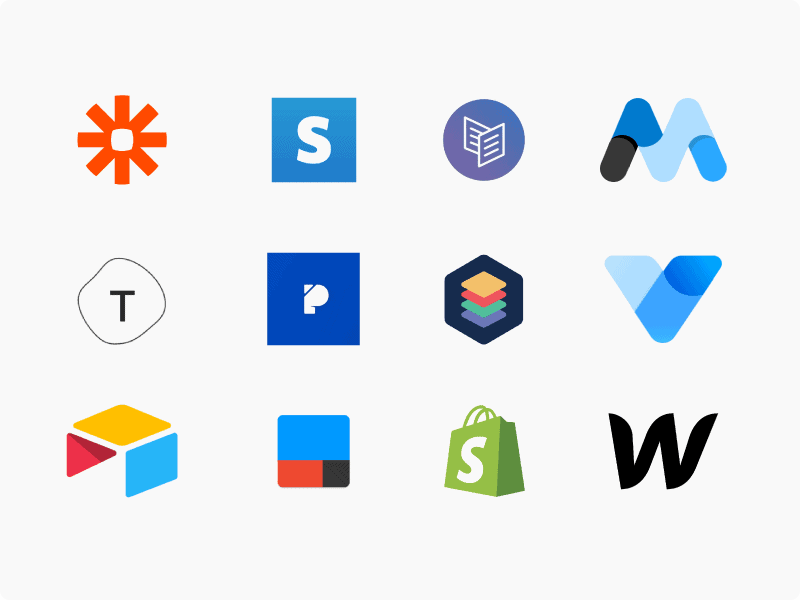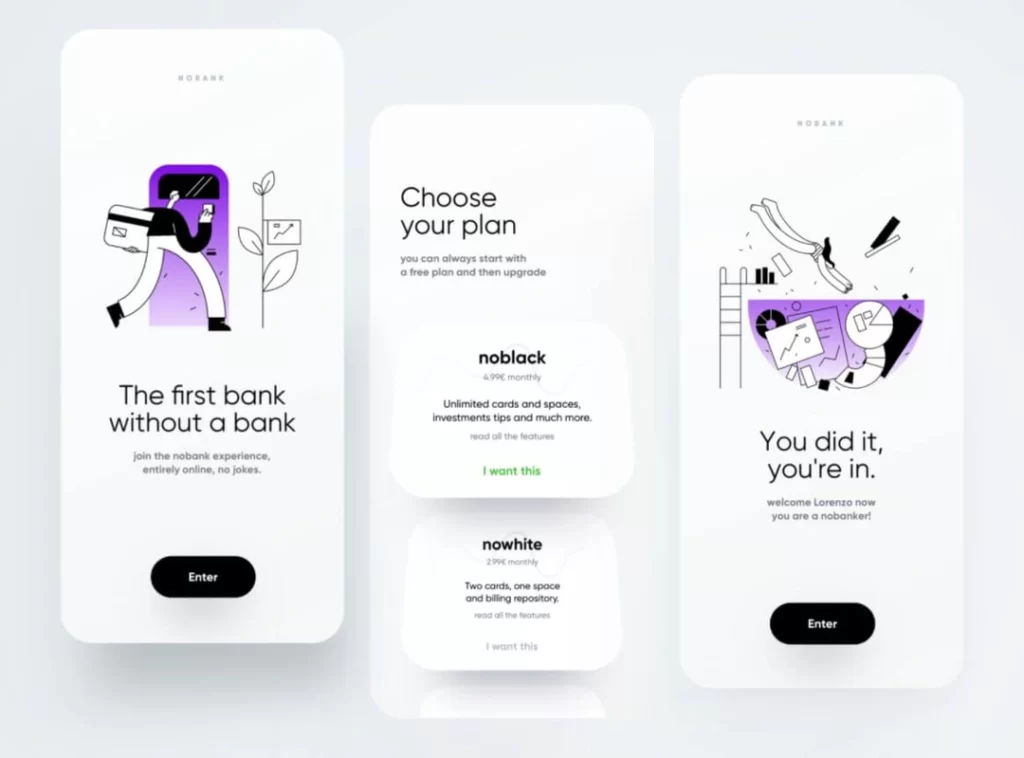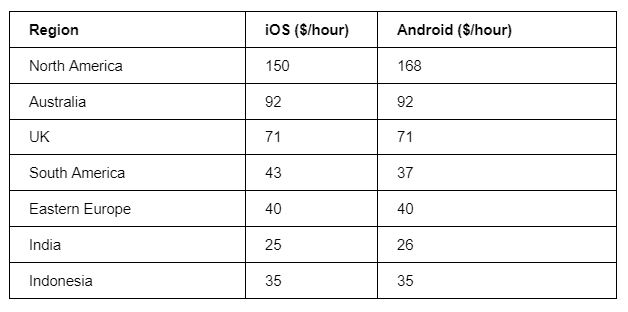Cost of App Design in 2024: Complete Breakdown
So, you have an excellent idea for an app. You envision it being the next big thing – maybe even the next TikTok or Instagram. But before dreams of fame and fortune, you must design and build this app. And that costs money – often much more than many first-time entrepreneurs realise.
In this comprehensive guide, we'll break down everything that goes into designing an app and the cost of app design in 2024 for top-quality work. I've been building apps for over a decade and have helped dozens of startups bring their ideas to life. I'll share real-world insight into app cost based on years of hard-won experience.
Buckle up! It's time to dive into the price tag for excellent app design…
Table of Contents
App Complexity
One of the most significant determinants of app design cost is the complexity of your app’s features and functionality. Apps can range from relatively simple to highly advanced:
- Simple apps – Have basic, straightforward features like informational content, calculators, and fundamental social engagement. Generally, it takes 1-3 months and $15,000-$30,000+ for design.
- Moderately complex apps – Have more advanced features like user logins, data collection/syncing, multimedia content, and two-way communication/notifications. Generally, it takes 3-6 months and $30,000-$70,000+ for design.
- Highly complex apps – Have sophisticated, custom features like travel/booking systems, financial platforms, real-time collaboration, AI integration, and administrative portals. Generally, it takes 6-12+ months and $100,000+ for design.
As you can see, app complexity significantly impacts the timeline and budget. Defining your must-have features is essential to estimating effort and costs.
Platforms and Devices

Will your app be available on iOS, Android, web, or all three? Designing for multiple platforms adds cost.
- iOS – Apple users represent an attractive market, but iOS development requires Swift/Objective-C and Xcode tools, which are generally the highest-cost platforms.
- Android – Google Play has a vast global reach, but fragmentation across devices and OS versions adds QA testing needs—generally moderate cost platform.
- Web – Broadest access with responsive web design, but requires advanced skills like React or Angular for complex apps. Generally, it is the lowest-cost platform.
- Multi-platform – To reach all users, you’ll need both native iOS and Android apps plus a mobile-friendly website. Plan for 3x the design effort compared to a single OS.
Devices also impact cost. Is your app phone-only or tablet-compatible? Simple apps may work across devices, while complex apps require optimised UI/UX for each form factor.
Visual Design
Visual design hugely impacts user engagement and app success. Investment in UX design, custom graphics, high-quality images, animations and micro-interactions can pay dividends in adoption and retention. Aspects to consider include:
- User interface (UI) – Controls and navigation should be intuitive yet distinct. More complex UI requires more design effort.
- User experience (UX) – User flows through the app should align with goals and behaviours. Defining interaction models and testing prototypes is critical.
- Brand identity – Consistent style, logo, colours/palettes, iconography, imagery and tone of voice convey brand values.
- Information architecture – Clear content structure and hierarchy enables users to find and absorb information quickly.
You can utilise off-the-shelf UI libraries and templates to reduce costs. But, investing in a custom visual design tailored to your audience has significant long-term benefits for standing out.
Location of Design Team
App design teams span locations and time zones. Where you choose to hire has cost implications:
- United States – $100-$150+ per hour for app design services. Highest rates but large talent pools in tech hubs like Silicon Valley and New York City.
- In Western Europe, $60-$100+ per hour is typical. London, Amsterdam, Paris and Berlin have excellent digital design talent.
- Eastern Europe – $30-$100 per hour, depending on experience level. Fast-growing hubs with strong tech talent like Ukraine and Poland.
- India – $20-$70 per hour for qualified candidates. Booming developer community, but language/cultural gaps can bring challenges.
- South America – $30-$60 per hour. Emerging markets like Columbia and Brazil have competitive digital talent.
While cost saving is tempting, talent level and communication fluency should also factor into location choice. A strong portfolio and testimonials provide confidence despite geographic distance.
Maintenance Needs
Ongoing app maintenance should be factored into lifelong costs:
- Hosting fees – Server and storage costs for supporting app usage
- Monitoring – Tracking performance metrics and logs
- Customer support – Handling user inquiries and technical issues
- Bug fixes/patches – Resolving code defects and optimising performance
- Feature updates – Enhancing features per user feedback
While less flashy than new features, app maintenance keeps your users happy and retained. Budget 15-25% of initial design cost per year for upkeep.
Additional Cost Drivers
Other aspects that influence app design costs include:
- Analytics integration – Usage tracking with services like Mixpanel or Firebase
- Payment capabilities – Accepting payments increases security considerations
- Real-time features – Chat, video, and collaboration require more complex logic
- Security needs – Encryption, access controls, data protection, add development time
- Branding extent – Highly branded apps require consistency across features and content
- Animations/transitions – Complex sequencing and prototypes increase UX design time
- External services integration – APIs like social media or geolocation add complexity
- App size – More screens/content requires additional UI and UX specification
- Data visualisations – Interactive charts, graphs and diagrams need custom programming
- Localisation – Supporting multiple languages multiplies strings to translate
While each item above may seem insignificant, they can add substantial effort across the design, copy, review and testing stages. Carefully prioritise must-have features at the start of your project to keep a handle on scope and cost.
The Factors That Make App Design So Expensive

So now that you know the many factors impacting cost, let’s explore why app design comes with such a hefty price tag. At a high level, an app consists of three key components:
App Strategy & Scope
Every app starts as an idea – but translating that into tangible requirements is tricky. Strategic positioning requires market analysis, use case evaluation, competitive research, and laying out functionality needs. Even small apps often undergo extensive strategic planning before design begins. And this planning is time-consuming to get right.
App Design
While some think this refers strictly to graphical interfaces, design encompasses far more—interaction paradigms, information architecture, workflow optimisation, and usability fall under the design umbrella. Crafting intuitive, pleasing, and efficient user experiences calls for expertise across multiple domains. It's far more complicated than just mocking up screens. Design sits at the core of good apps and demands significant resources.
App Engineering
With strategy sets and designs, developers start building app functionality. Front-end code brings interfaces to life, while back-end code adds complex logic. Then there’s infrastructure setup, structuring data flows, coding business rules, integrating APIs, implementing security protocols, and writing mountains of tests. App engineering is massively complex – and, therefore, costly for anything beyond essential apps. And since apps constantly evolve post-launch, engineering bills keep pouring in.
While outsourcing and low-code tools help, there’s no cheap or easy way to build production-grade apps alone. A severe undertaking calls for serious investments in planning, design, engineering, maintenance, and continuous evolution.
How App Complexity Drives Costs Up
In the app world, complexity gets cited constantly as projects grow more extensive and sophisticated. Let's examine complexity more closely and how it impacts budgets.
What Makes Apps Complex?
Apps only seem simple from the outside. Even essential apps possess hidden complexities driving up costs:
- Advanced Interfaces – Smooth animations, dynamic data displays, multi-touch gestures
- Custom Designs – Bespoke artwork, branded assets, high-resolution imagery
- Elaborate Workflows – Complex user stories, conditional displays, intricate logic
- Specialised Features – Unique functionality beyond standard libraries and SDKs
- Premium Integrations – Tapping premium 3rd-party APIs and services with fees attached
- Strict Security Needs – Rigorous protections for regulated data requiring custom development
- Challenging Performance Needs – Fast response times, smooth interactions, and small bundles all call for optimisation
- Multi-Platform Delivery – Adapting UI/UX for web, iOS, and Android, all while maintaining parity
- Frequent Updates – Rapid release cycles stress development teams and inflate costs
Even apps that look simple hide dozens of complex matters driving up timelines. And the more complex the app, the more costly each additional feature or design tweak becomes.
Complexity Creep Crushes Budgets
Many entrepreneurs bootstrap initial app dev with a fixed budget in mind. But complex apps often fall victim to “complexity creep”.
With so many interconnected and unknown variables, unforeseen challenges appear constantly. New edge cases, subtle bugs, performance issues, interoperability gaps, and hidden dependencies drag out timelines.
Design debates also lead product owners to layer on “just one more” feature. Scope creep kills budgets as every tiny tweak and change gets extensively tested and documented. Apps reach a tipping point where complexity expands exponentially while dev speed slows to a crawl.
Without diligent scoping, even straightforward apps become time and cost black holes. Managing complexity calls for strategic prioritisation and controlled release planning.
Hiring Specialised Talent Costs More Up Front – But Pays Off Through Faster Delivery Speeds

Another factor comes into play when assessing the costs of app design – the background and experience level of those doing the work.
App design spans so many disciplines that rarely can one person execute the entire process. Teams require a diversity of talent, including:
- Product Managers – Guide strategic planning
- Visual Designers – Craft stunning interfaces
- UI/UX Engineers – Make designs dynamic & interactive
- Backend Devs – Build complex logic and workflows
- Data Engineers – Model, store, and organise data flows
- DevOps Engineers – Streamline and automate deployments
- Quality Assurance – Rigorously test across environments
- Cloud Architects – Scale secure infrastructure
Very few people possess expertise across so many areas. So, staffing app projects calls for assembling teams with specialised skills.
Hiring specialists does cost more upfront. But they work much faster while producing higher-quality work. Lean, hyper-specialized teams avoid costly gaps that drag out projects and quality assurance cycles.
The expertise specialisation also speeds up the creation of reusable frameworks, automation tooling and standardised components. These pay compounding dividends with each new project by eliminating duplicate work.
While generalisation may seem cheaper in the short term, overextended resources produce slower and weaker results. App design is the perfect case where hiring specialised talent cuts total costs through faster delivery of better products.
Cost Saving Tips
If your budget is tight, there are avenues to reduce app design costs:
- Work with freelancers or small agencies to reduce overhead expenses
- Opt for an app template as a starting point instead of a custom UI
- Omit advanced but non-essential features to streamline complexity
- Prioritise one primary platform (iOS or Android) for initial launch
- Reuse existing brand assets like colours, fonts and icons if available
- Consider an app builder for fundamental apps instead of custom programming
- Allocate essential UI first launch and enhance with future releases
- Assign an internal point person to work closely with the development team on UX decisions
- Set milestone-based payments to match budget availability
The goal is to balance controlling costs while retaining core features that set your app apart. Users perceive the quality and capabilities you deliver–not necessarily the effort required behind the scenes. Prioritisation is key.
How Low-Code Tools Can Reduce App Design Costs

As app projects grow in scope, many now look to low-code platforms as an alternative to costly traditional coding. The low-code approach offers intuitive visual tooling for building apps without intensive programming.
Leading options include OutSystems, Appian, Mendix, and Microsoft Power Apps. These platforms provide drag-and-drop UIs for modelling data structures, designing interfaces, configuring logic flows, and defining integrations. Low-code comes packed with pre-built components for fast construction with minimal hand-coding.
Proponents argue that low-code solutions speed delivery at significantly lower cost points than traditional coding. But does the pitch live up to the reality?
Low-Code Capabilities & Limitations
Low-code platforms excel at:
- Rapid modelling of standard components
- Quick assembly of simple data workflows
- Fast configuration of standard interfaces and modules
But most fall short when it comes to:
- Complex custom interfaces
- Specialised non-standard integrations
- Intensive backend processing needs
- Stringent security protocols
- Multi-platform parity
- Dynamic scaling demands
While low-code solutions cost less than custom coding, they don't eliminate expenses. Many still require developers to handle complex logic, custom designs, expansive test automation, and advanced integration.
Hidden expenses also accumulate over time as apps built on proprietary low-code platforms often entail vendor lock-in. Porting away drives up future costs while inhibiting flexibility.
So, while low code can cost less for simple apps, recognised platforms have genuine limits before adoption. As app complexity increases, so does dependency on technical specialists – even with low-code tooling.
App Design Cost Estimator
To summarise considerations so far, app design costs break down into:
- Project Definition & Specification – 10-15% of total budget
- Gathering requirements
- Research & analysis
- Concept validation
- UI and Visual Design – 15-25% of total
- Wireframing & prototyping
- Custom graphic assets
- Brand identity & style guide
- Development – 50-60% of total
- Coding/programming
- External service integrations
- Animations & micro-interactions
- Testing & Deployment – 15-20% of total budget
- Bug fixing
- Submission to app stores
- Installation on servers
The table below provides cost ranges for apps by complexity across both iOS and Android:
| App Complexity | Timeline | Budget Range |
| Basic | 3-5 months | $30,000-$60,000 |
| Moderate | 5-8 months | $60,000-$150,000 |
| Advanced | 8-12+ months | $100,000-$250,000+ |
Mid-range options often deliver the right level of features versus cost efficiency. However, budget expectations can shift upwards or downwards significantly based on exact scope requirements.
An experienced app design firm can translate your vision and goals into tailored effort estimates after evaluating the following:
- Features and functionality needed
- Visual design investment
- Development platforms and devices
- Performance requirements
- Post-launch support needs
Hourly or project-based quotes reflect the precise attributes that influence costs for your custom app.
App Design Cost Breakdown Examples
To further illustrate how app design budgets take shape, three examples spanning industries and complexity levels are below.
Fitness Tracker App
A startup wants to launch a personal fitness tracking app allowing users to set diet and exercise goals and then record progress. Key features:
- User account registration
- Goal and metric selections
- Tracking forms for meals, workouts and body measurements
- Charts and stats for monitoring progress over time
- A social community for sharing advice and motivation
With moderate complexity spanning custom tracked forms, data visualisations, user-generated content and notifications, the total cost estimate is $110,000 over seven months for launch.
Geography Quiz Learning App
An educator aims to gamify geography education for kids via an interactive world map quiz app. Students explore country locations and cultural facts. Key app features:
- Interactive world map with country info
- Flag, landmark and capital photo galleries
- Quizzes on locations, flags and facts
- Dashboard tracking quiz scores over time
- Badge incentives awarded for achievements
With various custom multimedia content and learning features aimed at children, the total cost estimate for launch is $85,000 over five months.
Enterprise Inventory Management App
A construction firm seeks to optimise equipment tracking and maintenance via a custom company app. Features include:
- Equipment database profiles and categories
- Barcode/serial number scans using the phone camera
- Location GPS stamps for equipment in the field
- Service and repair logs showing work history
- Status and utilisation reporting for analysis
Given backend integration complexities with the existing assets system, advanced barcode scanning, and GPS features, the total cost estimate is $230,000+ over ten months for a multi-platform launch.
Key Takeaways
If defining your app’s cost and effort still seems daunting, focus first on articulating:
- Primary platforms and devices
- Critical feature differentiators
- Target user groups and needs
An app development shop can then map effort levels to your capabilities framework. Cost goes hand in hand with quality–resist corners that compromise core utility that sets you apart. Apps that delight through robust visual design, reliable features and enjoyable interactions lead their field.
How Much Does App Design Cost on Average?

Okay, we've explored the many factors impacting costs and why app design comes saddled with hefty price tags. It's time to benchmark some ballpark figures for spending expectations in 2024.
Let's break this down across common categories and project scopes…
Simple Apps
- Budget Range: $25,000 – $150,000+
- Description: Apps with basic functionality, standard interfaces, simple logic, and lightweight data requirements. Examples: 2D games, simple business apps, and primary social platforms.
- Technical Scope: Frontend-focused web/mobile apps with simple, pre-built UI components on standard frameworks. May connect with 1-2 essential third-party services (e.g. file storage, email, payments). It has limited custom backend logic. It relies heavily on low-code tools or client-side frameworks with fast dev speeds but less customisation.
Intermediate Apps
- Budget Range: $150,000 – $500,000+
- Description: Robust consumer and business apps with customised designs, structured workflows, dynamic interfaces, and diverse feature sets. Includes most startup MVPs, spin-off product prototypes, mid-complexity SaaS web/mobile tools, and marketplace platforms.
- Technical Scope: Custom frontend UI/UX design with interactive experiences, real-time interfaces, and animation. Customised branding and visual language. IoT integration and synchronisation capabilities. Backed by relational data storage and standardised backends for complex processing and designed for high-performance demands and scalability best practices early on.
Advanced Apps
- Budget Range: $500,000+
- Description: Highly complex apps with intricate workflows, immersive designs, diverse integrations, explosive scalability needs and rigid performance demands. Includes next-gen consumer platforms, full-scale enterprise SaaS suites, and machine learning-infused apps.
- Technical Scope: Fully custom UI/UX design built exclusively with specialised internal and third-party components. State-of-the-art visualisation and animation capabilities. Powerful backends are constructed to handle immense data processing loads. The foundation of core frameworks optimised for scaling, speed, and resiliency. Time series data stores. Microservices architectures and continuous delivery mindsets.
As you can see, costs span a massive range depending on project scope and technical complexity. And the price tag keeps rising as platforms succeed and product ambitions expand.
But the “simple, intermediate, advanced” framework provides ballpark figures to assess budget needs as you plan your next app project.
Unexpected Costs That Can Sabotage App Budgets

Crunching the numbers on potential app costs brings tremendous clarity to budgeting discussions. But seasoned veterans know that even the best projections crash into reality once development begins.
Why? Apps attract unexpected costs that sneak attack budgets constantly:
Market Research
You have to test demand before diving all in on building anything, right? However, conducting online surveys, buyer interviews, landing page experiments, and focus group studies cost real money, so a few plans are needed upfront.
Legal Fees
Lawyers make out well in the app economy, from incorporation to fundraising docs to privacy policies to terms of service. And those billable hours add up fast.
Extended Prototyping
Concepts that make perfect sense on paper often reveal flaws or lack convincing resonance with real users. Refining takes time and money.
Visual Asset Production
Beautiful custom interfaces demand attractive custom visual assets. Designers, animators and photographers don’t come cheap, even if apps won’t succeed without them.
Feature Creep
“As long as we’re building this one extra feature, why not add just one more for a few thousand more?” It rarely ends well as complexity explodes uncontrollably.
Technical Debt Interest
Sloppy code, patchwork infrastructure, and duct-taped integration you justified as “temporary winners” cost more when things inevitably break.
Platform Licensing Fees
Got to spend money to make money? Hidden access fees sneak into budgets for app store listings, API subscriptions, mandatory compliance audits, and premium tooling. It adds up.
Upkeep & Operations
Set it and forget it? Hardly. Budgets overlook that apps require constant upkeep, maintenance, troubleshooting and feature expansion post-launch.
App costs don't disappear once designs get approved and features are built. Instead, costs persist long after launch in the form of fixes, upkeep, enhancements, and technical debt interest payments.
Apps that gain adoption also gain expenses over time. Scaling user bases is excellent news for growth but puts increased pressure on shrinking budgets.
Continuous spending is inevitable but is seldom planned for properly upfront. So, recognise launch day marks just the beginning rather than the end goal for app costs.
Conclusion
If reading this far hasn't scared you away yet, chances are good you may just be an entrepreneur crazy enough to build an app in 2024! I applaud the courage and commitment it takes to bring app ideas to life.
I aimed to give founders and innovators an extensive insider perspective on calculating actual app costs. By understanding what drives budgets up and planning accordingly, you can pursue development smartly.
I wish you nothing but success as you design the next big thing! Feel free to reach out if you have any other questions during your journey to App Store glory!
FAQs on the Cost of App Design
What is the average cost to develop an app?
For relatively simple apps, budgets often land in the $150,000 to $250,000 range. Intermediate complexity apps generally cost $250,000 to $500,000+. Highly complex apps start at $500,000 on average. But all these costs can double or triple if projects expand in scope or pivot directions mid-stream.
How much does app design cost per hour?
Industry averages peg hourly rates for senior app designers and engineers between $50-$150 per hour. Mid-level talent runs $30-$90 per hour, and offshore contractors or agencies charge as little as $25 per hour upwards. Per-hour costs vary wildly by experience levels, specialisations, and geographies.
What is a typical budget for a basic MVP app?
For early-stage startups, mobile or web MVP budgets often start around $150,000. This allows for core essential features along with solid UI/UX design. However, many find they underestimate complexity during MVP builds. This drives average costs closer to $250,000 without scoping solid discipline.
Why does designing apps cost so much compared to websites?
Unlike simple brochureware websites, apps feature dynamic real-time interfaces, complex workflows, rigorous offline support, specialised APIs/hardware integrations, precise location/notification components, strict security protocols and expansive backend infrastructure. This added complexity multiplies costs significantly in contrast to basic websites.
How long does it take to design and build an app?
Simple apps may only require 1-2 months from planning through launch. However, release cycles typically run 6+ months for intermediate-complexity apps. Highly advanced projects often take 9-12 months from kickoff to delivering an initial usable version. And some enterprise-scale initiatives unfold over multiple years before all requirements get built into apps.
Can I create an app myself without hiring expensive developers?
Limited coding skills may work for simple hobby projects. But launching highly functional production-grade apps alone is a tall order for nearly all first-timers. While do-it-yourself app builder platforms exist, most require hiring specialised help to handle complex logic, custom designs, integrations and intensive quality assurance. Solo dev careers take years, if not decades, to build the skills to engineer full-featured apps alone.
